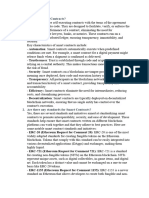0% found this document useful (0 votes)
15 views6 pagesUnit-1 QB
The document provides an overview of Smart Contracts, their role in Blockchain technology, and key terminologies associated with them. It discusses the interaction between Smart Contracts and cryptocurrencies, the architecture of Blockchain, and the functioning of the Ethereum Virtual Machine (EVM). Additionally, it highlights the advantages of Ethereum for Smart Contracts, real-world applications, security mechanisms, and the development lifecycle of Ethereum Smart Contracts.
Uploaded by
amantikrihaCopyright
© © All Rights Reserved
We take content rights seriously. If you suspect this is your content, claim it here.
Available Formats
Download as PDF, TXT or read online on Scribd
0% found this document useful (0 votes)
15 views6 pagesUnit-1 QB
The document provides an overview of Smart Contracts, their role in Blockchain technology, and key terminologies associated with them. It discusses the interaction between Smart Contracts and cryptocurrencies, the architecture of Blockchain, and the functioning of the Ethereum Virtual Machine (EVM). Additionally, it highlights the advantages of Ethereum for Smart Contracts, real-world applications, security mechanisms, and the development lifecycle of Ethereum Smart Contracts.
Uploaded by
amantikrihaCopyright
© © All Rights Reserved
We take content rights seriously. If you suspect this is your content, claim it here.
Available Formats
Download as PDF, TXT or read online on Scribd
/ 6





























































































